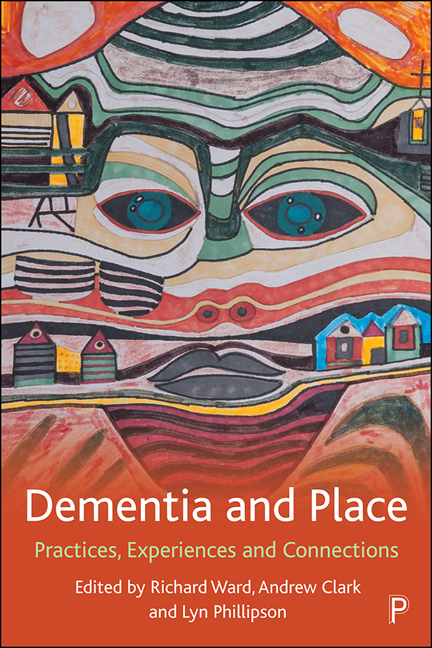Book contents
- Frontmatter
- Dedication
- Contents
- List of figures and tables
- Notes on contributors
- Acknowledgements
- 1 Introduction: Placing dementia
- 2 Understanding the meaning of neighbourhoods for people living with dementia: the value of a relational lens
- 3 Moving house with dementia
- 4 How do people with dementia manage problematic situations in public spaces?
- 5 Making and maintaining neighbourhood connections when living alone with dementia
- 6 My neighbourhood, my future ...?
- 7 Enabling the neighbourhood: a case for rethinking dementia-friendly communities
- 8 A conceptual framework of the person– environment interaction in the neighbourhood among persons living with dementia: a focus on out-of-home mobility
- 9 We’re known as ‘the girls’ around town: support, isolation and belonging for a lesbian couple living with dementia
- 10 Building community capacity for dementia in Canada: new directions in new places
- 11 The good, the challenging and the supportive: mapping life with dementia in the community
- 12 Growing back into community: changes through life with dementia
- 13 Dementia, tourism and leisure: making the visitor economy dementia friendly
- 14 Conclusion: Dementia emplaced
- Index
14 - Conclusion: Dementia emplaced
Published online by Cambridge University Press: 13 May 2022
- Frontmatter
- Dedication
- Contents
- List of figures and tables
- Notes on contributors
- Acknowledgements
- 1 Introduction: Placing dementia
- 2 Understanding the meaning of neighbourhoods for people living with dementia: the value of a relational lens
- 3 Moving house with dementia
- 4 How do people with dementia manage problematic situations in public spaces?
- 5 Making and maintaining neighbourhood connections when living alone with dementia
- 6 My neighbourhood, my future ...?
- 7 Enabling the neighbourhood: a case for rethinking dementia-friendly communities
- 8 A conceptual framework of the person– environment interaction in the neighbourhood among persons living with dementia: a focus on out-of-home mobility
- 9 We’re known as ‘the girls’ around town: support, isolation and belonging for a lesbian couple living with dementia
- 10 Building community capacity for dementia in Canada: new directions in new places
- 11 The good, the challenging and the supportive: mapping life with dementia in the community
- 12 Growing back into community: changes through life with dementia
- 13 Dementia, tourism and leisure: making the visitor economy dementia friendly
- 14 Conclusion: Dementia emplaced
- Index
Summary
Thinking through dementia and place
In the Introduction to this book, we proposed that dementia and place are co-constitutive, discursively and experientially, but to date this relationship has yet to be given full consideration. This is not to overlook an extensive tradition of research into dementia and the environment, but rather to suggest that an explicit focus on how dementia comes to shape understandings and experiences of place, and vice versa, remains underdeveloped in the field of dementia studies. The preceding chapters find common ground or, more accurately, share a common starting point, of seeking to understand experiences of dementia through the locational lens of the neighbourhood. Yet while most of the chapters start out from here, few end up at the same end point. In part, this may be because a neighbourhood is a somewhat slippery concept, implying simultaneously a scale of perspective as well as a lived phenomenon worth investigating. Indeed, what emerges overall is how neighbourhoods can offer a particular position from which to enhance our understanding of life with dementia and, in turn, of how living with dementia provides sometimes unique and valuable ways of knowing what neighbourhoods are about.
The chapters demonstrate the diversity of theoretical and conceptual thinking about how we might approach and understand place-based experiences for those living with dementia. They also inform and extend the conceptual and theoretical stock of dementia studies, drawing on ideas already in circulation, such as personhood and social citizenship (Chapter 10), and borrowing from other disciplines and perspectives, such as transactional perspectives and place integration (Chapter 4), relational space (Chapter 2), models of social health (Chapter 11) and performativity (Chapter 7). The need for renewed attention to conceptual thinking about people in ‘local’ environments is explicitly seen in Seetharaman and colleagues’ (Chapter 8) exploration of the dynamic relationship between the person living with dementia and neighbourhood environments, which seeks to better integrate the physical and psychosocial dimensions of the neighbourhood environment in people's lives. The result there, and indeed across the book, are attempts to think differently not so much about life with dementia, but about life with dementia in and through place.
- Type
- Chapter
- Information
- Dementia and PlacePractices, Experiences and Connections, pp. 208 - 217Publisher: Bristol University PressPrint publication year: 2021



